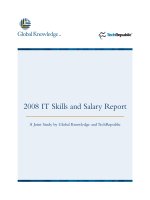Tài liệu TCP/IP Overview docx
Bạn đang xem bản rút gọn của tài liệu. Xem và tải ngay bản đầy đủ của tài liệu tại đây (191.52 KB, 15 trang )
Written and provided by
TCP/IP Overview
1-800-COURSES
www.globalknowledge.com
Expert Reference Series of White Papers
Table of Contents
TCP/IP Overview................................................................................................................................................1
Document ID: 13769................................................................................................................................1
Introduction..........................................................................................................................................................1
TCP/IP Technology.............................................................................................................................................2
TCP.........................................................................................................................................................2
IP.............................................................................................................................................................3
Routing in IP Environments...................................................................................................................5
Interior Routing Protocols....................................................................................................................................7
RIP..........................................................................................................................................................7
IGRP.......................................................................................................................................................7
EIGRP.....................................................................................................................................................7
OSPF.......................................................................................................................................................8
Integrated IS−IS......................................................................................................................................8
Exterior Routing Protocols..................................................................................................................................8
EGP.........................................................................................................................................................8
BGP.........................................................................................................................................................8
Cisco's TCP/IP Implementation...........................................................................................................................9
Access Restrictions.................................................................................................................................9
Tunneling................................................................................................................................................9
IP Multicast.............................................................................................................................................9
Suppressing Network Information........................................................................................................10
Administrative Distance........................................................................................................................10
Routing Protocol Redistribution...........................................................................................................10
Serverless Network Support.................................................................................................................10
Network Monitoring and Debugging....................................................................................................10
Summary............................................................................................................................................................11
NetPro Discussion Forums − Featured Conversations......................................................................................11
Related Information...........................................................................................................................................11
Cisco − TCP/IP Overview
i
TCP/IP Overview
Document ID: 13769
Introduction
TCP/IP Technology
TCP
IP
Routing in IP Environments
Interior Routing Protocols
RIP
IGRP
EIGRP
OSPF
Integrated IS−IS
Exterior Routing Protocols
EGP
BGP
Cisco's TCP/IP Implementation
Access Restrictions
Tunneling
IP Multicast
Suppressing Network Information
Administrative Distance
Routing Protocol Redistribution
Serverless Network Support
Network Monitoring and Debugging
Summary
NetPro Discussion Forums − Featured Conversations
Related Information
Introduction
In the two decades since their invention, the heterogeneity of networks has expanded further with the
deployment of Ethernet, Token Ring, Fiber Distributed Data Interface (FDDI), X.25, Frame Relay, Switched
Multimegabit Data Service (SMDS), Integrated Services Digital Network (ISDN), and most recently,
Asynchronous Transfer Mode (ATM). The Internet protocols are the best proven approach to internetworking
this diverse range of LAN and WAN technologies.
The Internet Protocol suite includes not only lower−level specifications, such as Transmission Control
Protocol (TCP) and Internet Protocol (IP), but specifications for such common applications as electronic mail,
terminal emulation, and file transfer. Figure 1 shows the TCP/IP protocol suite in relation to the OSI
Reference model. Figure 2 shows some of the important Internet protocols and their relationship to the OSI
Reference Model. For information on the OSI Reference model and the role of each layer, please refer to the
document Internetworking Basics.
The Internet protocols are the most widely implemented multivendor protocol suite in use today. Support for
at least part of the Internet Protocol suite is available from virtually every computer vendor.
Cisco − TCP/IP Overview
TCP/IP Technology
This section describes technical aspects of TCP, IP, related protocols, and the environments in which these
protocols operate. Because the primary focus of this document is routing (a layer 3 function), the discussion of
TCP (a layer 4 protocol) will be relatively brief.
TCP
TCP is a connection−oriented transport protocol that sends data as an unstructured stream of bytes. By using
sequence numbers and acknowledgment messages, TCP can provide a sending node with delivery information
about packets transmitted to a destination node. Where data has been lost in transit from source to destination,
TCP can retransmit the data until either a timeout condition is reached or until successful delivery has been
achieved. TCP can also recognize duplicate messages and will discard them appropriately. If the sending
computer is transmitting too fast for the receiving computer, TCP can employ flow control mechanisms to
slow data transfer. TCP can also communicates delivery information to the upper−layer protocols and
applications it supports. All these characteristics makes TCP an end−to−end reliable transport protocol. TCP
is specified in RFC 793 .
Figure 1 TCP/IP Protocol Suite in Relation to the OSI Reference Model
Figure 2 Important Internet Protocols in Relation to the OSI Reference Model
Cisco − TCP/IP Overview
Refer to the TCP section of Internet Protocols for more information.
IP
IP is the primary Layer 3 protocol in the Internet suite. In addition to internetwork routing, IP provides error
reporting and fragmentation and reassembly of information units called datagrams for transmission over
networks with different maximum data unit sizes. IP represents the heart of the Internet Protocol suite.
Note: The term IP in the section refers to IPv4 unless otherwise stated explicitly.
IP addresses are globally unique, 32−bit numbers assigned by the Network Information Center. Globally
unique addresses permit IP networks anywhere in the world to communicate with each other.
An IP address is divided into two parts. The first part designates the network address while the second part
designates the host address.
The IP address space is divided into different network classes. Class A networks are intended mainly for use
with a few very large networks, because they provide only 8 bits for the network address field. Class B
networks allocate 16 bits, and Class C networks allocate 24 bits for the network address field. Class C
networks only provide 8 bits for the host field, however, so the number of hosts per network may be a limiting
factor. In all three cases, the left most bit(s) indicate the network class. IP addresses are written in dotted
decimal format; for example, 34.0.0.1. Figure 3 shows the address formats for Class A, B, and C IP networks.
Figure 3 Address Formats for Class A, B, and C IP Networks
Cisco − TCP/IP Overview
IP networks also can be divided into smaller units called subnetworks or "subnets." Subnets provide extra
flexibility for the network administrator. For example, assume that a network has been assigned a Class A
address and all the nodes on the network use a Class A address. Further assume that the dotted decimal
representation of this network's address is 34.0.0.0. (All zeros in the host field of an address specify the entire
network.) The administrator can subdivide the network using subnetting. This is done by "borrowing" bits
from the host portion of the address and using them as a subnet field, as depicted in Figure 4.
Figure 4 "Borrowing" Bits
If the network administrator has chosen to use 8 bits of subnetting, the second octet of a Class A IP address
provides the subnet number. In our example, address 34.1.0.0 refers to network 34, subnet 1; address 34.2.0.0
refers to network 34, subnet 2, and so on.
The number of bits that can be borrowed for the subnet address varies. To specify how many bits are used to
represent the network and the subnet portion of the address, IP provides subnet masks. Subnet masks use the
same format and representation technique as IP addresses. Subnet masks have ones in all bits except those that
specify the host field. For example, the subnet mask that specifies 8 bits of subnetting for Class A address
34.0.0.0 is 255.255.0.0. The subnet mask that specifies 16 bits of subnetting for Class A address 34.0.0.0 is
255.255.255.0. Both of these subnet masks are pictured in Figure 5. Subnet masks can be passed through a
network on demand so that new nodes can learn how many bits of subnetting are being used on their network.
Figure 5 Subnet Masks
Traditionally, all subnets of the same network number used the same subnet mask. In other words, a network
manager would choose an eight−bit mask for all subnets in the network. This strategy is easy to manage for
Cisco − TCP/IP Overview









